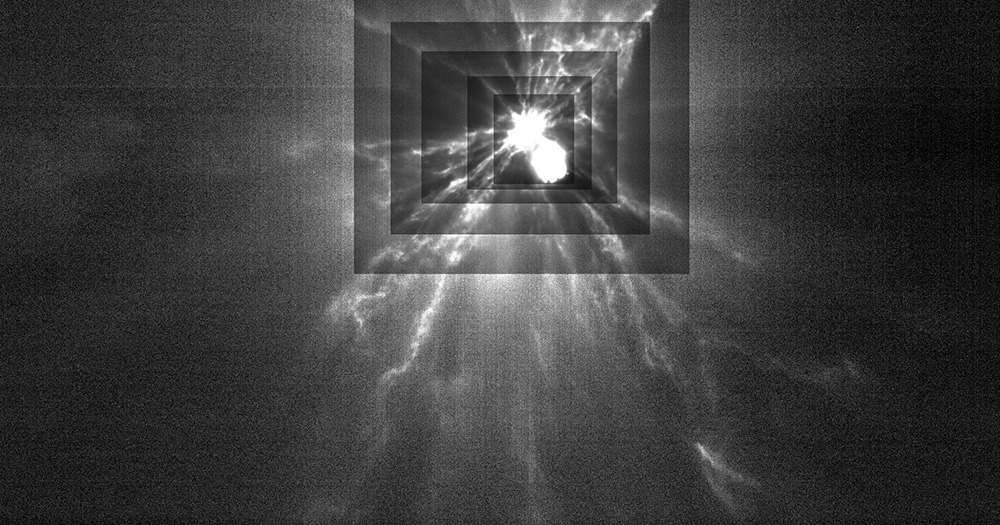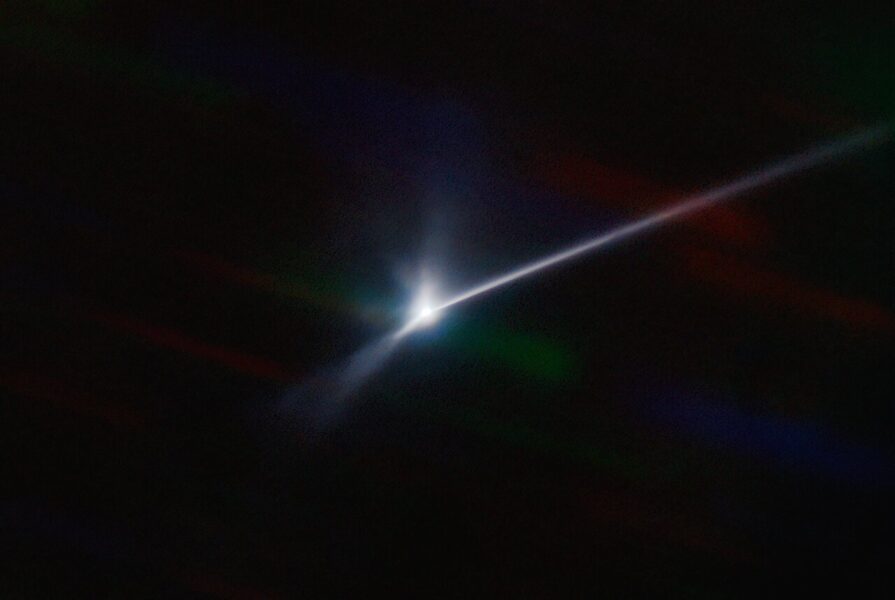They needed to shorten the moon’s orbit by 73 seconds. They shortened it by more than half an hour.
NASA announced today at a press briefing that the Double Asteroid Redirect Test’s attempt to alter the path of an asteroid moon had succeeded beyond expectations — though not beyond hopes.
Before the DART spacecraft slammed head-on into Dimorphos, the moon of asteroid 65803 Didymos, the moon orbited its primary in about 11 hours, 55 minutes. It now takes only 11 hours, 23 minutes (plus or minus 2 minutes) to complete its orbit. The large change — 32 minutes — was within the range predicted before the impact, but at the top end of what was possible.

ASI / NASA / APL
If Dimorphos had been a strong, solid body, the recoil from the impact would not have been nearly so large. The impressive plumes of ejecta streaming out from the head-on impact likely contributed a recoil effect, acting a bit like a retrorocket. For every action, there is an equal and opposite reaction: By launching material toward Dimorphos’ direction of motion, Dimorphos’ velocity changed just as much in the opposite direction.
The mission confirmed the measurement using visible light and radar. With both ground- and space-based optical telescopes, they recorded lightcurves of the Didymos system as the two components alternately eclipsed each other: small, brief dips in brightness as Dimorphos casts a shadow on Didymos, and larger, longer dips as Dimorphos passes through Didymos’ shadow. The cadence of these dips changed with the faster orbit of Dimorphos.

CTIO / NOIRLab / SOAR / NSF / AURA / T. Kareta (Lowell Observatory), M. Knight (US Naval Academy); Image processing: T.A. Rector (University of Alaska Anchorage / NSF’s NOIRLab), M. Zamani & D. de Martin (NSF’s NOIRLab)
The radar method was independent of the optical one. Radio telescopes like those at Goldstone in southern California and Green Bank in West Virginia actively broadcast radar waves at the Dimorphos system and watched for the reflected signal. The time of arrival of the returned signal (the “delay”) depends on the range to the target; the frequency of the returned signal (the “Doppler”) will be the same as the broadcast frequency if the object is at a standstill relative to the telescope, and higher or lower if the object is moving toward or away from the telescope. Following the DART impact, Doppler-delay radar images of the Didymos-Dimorphos system showed that the moonlet had neither the position nor velocity expected from the pre-impact orbit, and the new orbital speed derived from radio observations closely matched the optical ones.

NASA / Johns Hopkins APL / NASA JPL Goldstone Planetary Radar / NSF’s Green Bank Observatory
This announcement is just the first result of the DART experiment. Lots more questions remain. How much mass was ejected? How big were the particles — all dust? Some larger? Were any large enough to be hazardous? Was the impact large enough to introduce a wobble into Dimorphos’ spin pole? If so, how long will it take for grinding within the moonlet to make that wobble go away?
Much more work remains on the immense amount of information encoded in the dramatic ejecta plumes and long comet-like dust tail. It will take years to reap the full harvest of science!

ASI / NASA
 8
8









Comments
Stephen Gagnon
October 11, 2022 at 11:05 pm
"By launching material toward Dimorphos’ direction of motion, Dimorphos’ velocity changed just as much in the opposite direction." More accurately, Dimorphos’ momentum changed just as much in the opposite direction.
You must be logged in to post a comment.
John-Pane
October 12, 2022 at 5:11 pm
How is a reduction in the orbit time considered to have "slowed it"?
You must be logged in to post a comment.
John-Pane
October 12, 2022 at 5:16 pm
A reduction in velocity makes sense but the headline is about orbital period.
You must be logged in to post a comment.
Stephen Gagnon
October 12, 2022 at 6:17 pm
Imagine that its orbit was perfectly circular to begin with. It would have the same speed at every point. Now, imagine that it's speed is reduced. Suddenly, it's moving too slowly to remain at that distance. Its orbit is no longer circular, but elliptical, with the closest point being opposite that of where the speed reduction took place. So, two things that result in a shorted orbital period. First, the 'circumference' of the elliptical orbit is smaller than the circumference of the circular orbit. There's physically less distance to travel with the newer orbit. Second, as the satellite 'falls' towards its parent, it speeds up. It's entirely possible that the satellite will travel faster than its pre-impact speed along the closest parts of its orbit.
You must be logged in to post a comment.
Monica Young
October 17, 2022 at 11:51 am
Apologies for the error, that should have read "shortened" rather than "slowed."
You must be logged in to post a comment.
Jim DeCamp
October 14, 2022 at 12:21 pm
Apparently, the initial impact slowed the moonlet down, causing it to drop into a less energetic orbit, like firing retrorockets on a spacecraft. The smaller orbit is also faster, has more kinetic energy, but less gravitational potential energy. It takes added energy to move a satellite into a higher orbit, but it will have longer period, and move more slowly.
You must be logged in to post a comment.
Howard Ritter
October 14, 2022 at 9:06 pm
NASA‘s news release only addressed the change in the mutual orbital period of Dimorphos and Didymos. But the goal of an operational impact mission will be to alter the solar-orbital trajectory of a minor planet that has the potential of impacting the Earth.
NASA scientists know the magnitude and direction of the momentum vector of the DART probe and how much the mutual orbital period of the system was changed. Presumably they can now make inferences about how much momentum was transferred to Dimorphos and thus to the entire system (less than the probe’s momentum, some of which was carried away by ejecta whose velocity exceeded the escape velocity from the Didymos-Dimorphos system). This in turn would enable them to calculate changes in the solar period and other orbital elements of the pair.
Has NASA mentioned anything along these lines, or speculated on how long a period of observation it will take before a change in trajectory can actually be detected? I would presume NASA is planning to do this, unless the precision with which the original orbit was known is too imprecise, or future perturbations too great, for this to be possible.
You must be logged in to post a comment.
Dr Jay
November 6, 2022 at 5:50 pm
The statement "By launching material toward Dimorphos’ direction of motion, Dimorphos’ velocity changed just as much in the opposite direction." is incorrect. The momentum is conserved, which is the product of mass and velocity. By Newton's 3rd Law, the change in momentum is the same for both objects if they retain their original masses. In this case, the total momentum of the system of the probe and the moon before the collision will be equal to the total momentum of all the objects (probe, moon, fragments, debris, etc.) after the collision. That cannot be calculated precisely without knowing the masses and directions of all the individual pieces, but it can be approximated to within some range of uncertainty. The velocity of the moon after the impact decreased; therefore, the moon dropped into a lower orbit with a shorter period. It is much easier to measure the orbital period than it is to measure the speeds and directions of debris.
The statement can be corrected by either replacing the word "velocity" with "momentum", but with the caveat that when stated this way, it assumes only 2 objects (the probe and the moon) with no ejecta or debris field. If the probe stuck to the moon and embedded itself into the moon, this would constitute a perfectly inelastic collision, as opposed to a perfectly elastic collision like billiard balls. The actual collision is more complicated because of the multiple fragments. In principle, it can be calculated precisely if the speeds and directions of all the outgoing fragments were known. However, the easier fix is just to eliminate the phrase "just as much", and add a statement about the law of momentum conservation. For example, "By launching material toward Dimorphos’ direction of motion, Dimorphos’ velocity changed in the opposite direction, according to the conservation of momentum." Or something similar.
You must be logged in to post a comment.
You must be logged in to post a comment.